1. General Discussion
1.1 Background
1.1.1 History
The previous
partially validated method for acetic acid, ID-186SG, called for
collection on charcoal tubes and extraction with 1.5 mM sodium
borate.1
An extraction study of acetic acid using coconut shell charcoal ( SKC
Anasorb CSC, lot 2000) using 1.5 mM sodium borate had non-linear
extraction efficiencies, which ranged from 99.3% for a 2.098 mg
loading to 66.8% for a 0.105 mg loading. Extraction studies using 0.01
N NaOH had an average recovery of 98.6 over the range of 0.15 to 2.31
mg loading. Retention studies showed no loss of acetic acid when 48 L
of humid air (~80% RH) was drawn through spiked tubes at 0.2 L/min.
Storage studies showed little loss when stored for 14 days at either
refrigerated or ambient temperatures.
1.1.2 Toxic effects (This section is for information
only and should not be taken as the basis of OSHA policy.)2
Acetic acid is a severe skin, eye and mucous membrane
irritant. As an eye irritant it can cause burns, lachrymation, and
conjunctivitis. Skin exposure can cause burns. Mucous membrane
exposure results in burns and bleeding from ulcerations, along with
nausea, vomiting and diarrhea.
1.1.3 Workplace exposure3,4
Acetic acid is used as a feedstock in the production of
acetates, acetyls, cellulose acetate, acetate rayon, and plastics. It
is used as a laundry sour, in tanning, and printing and dyeing. It is
used as an acidulant and preservative in foods and pharmaceuticals. It
is used as a solvent for gums, resins, volatile oils, and other
organic compounds. In 2002 4.8 billion pounds of acetic acid were
produced in the US.
1.1.4 Physical properties and other
descriptive information5,6
| CAS number: |
64-19-7 |
IMIS: |
00207
|
| synonyms: |
glacial acetic acid;
methane carboxylic acid; ethanoic acid; vinegar acid |
| RTECS number: |
AF1225000 |
molecular weight: |
60.05 |
| melting point: |
16.7ºC |
boiling point: |
118ºC |
| appearance: |
clear liquid |
molecular formula: |
C2H4O2
|
| odor: |
vinegar |
flash point: |
39ºC (103ºF)(cc) |
| autoignition |
|
vapor |
11.52 kPa or |
| temperature: |
465ºC (869ºF) |
pressure: |
11.4 mm Hg @ 20ºC |
| solubility: |
water, alcohol, ether |
density: |
1.049 |
| structural formula: |
 |
|
|
This method was evaluated according to the OSHA
SLTC "Evaluation Guidelines for Air Sampling Methods Utilizing
Chromatographic Analysis".8
The Guidelines define analytical parameters, specify required
laboratory tests, statistical calculations and acceptance criteria.
The analyte air concentrations throughout this method are based on the
recommended sampling and analytical parameters.
1.2 Detection limit of the overall
procedure (DLOP) and reliable quantitation limit (RQL)
The DLOP
is measured as mass per sample and expressed as equivalent air
concentrations, based on the recommended sampling parameters. Ten
samplers were spiked with equal descending increments of analyte, such
that the lowest sampler loading was 1.02 µg of
acetic acid. This is the amount spiked on a sampler that would produce a
peak approximately 10 times the response for a sample blank. These
spiked samplers were analyzed with the recommended analytical
parameters, and the data obtained used to calculate the required
parameters (standard error of estimate and slope) for the calculation of
the DLOP. The slope was 2.29×104 and the SEE was 783.3. The
RQL is considered the lower limit for precise quantitative measurements.
It is determined from the regression line parameters obtained for the
calculation of the DLOP, providing 75% to 125% of the analyte is
recovered. The DLOP and RQL were 0.103 µg and
0.342 µg respectively.
Table
1.2
Detection Limit of the Overall Procedure for Acetic
acid |
|
mass
per sample
(µg) |
area
counts
(µV-s) |
|
| |
0.00 |
|
0 |
|
0.102 |
|
1449 |
|
0.204 |
|
3508 |
|
0.306 |
|
5138 |
|
0.408 |
|
7505 |
|
0.510 |
|
9314 |
|
0.612 |
|
11963 |
|
0.714 |
|
15314 |
|
0.816 |
|
17662 |
|
0.918 |
|
20064 |
|
1.02 |
|
23125 | |
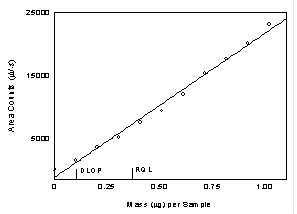
Figure
1.2.1 Plot of data to determine the DLOP/RQL for acetic acid.
(Y=2.29x104 X - 1240; SEE=783.3) |
|
Below is a chromatogram of the RQL level.
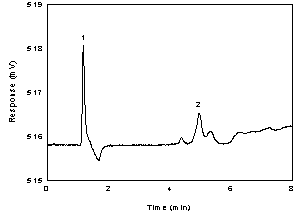
Figure
1.2.2. Chromatogram of the acetic acid standard, as the acetate
ion, near the RQL. (Key: (1) water; (2) acetate
ion) | 2. Sampling
Procedure
All safety practices that apply to the work area being
sampled should be followed. The sampling equipment should be attached to
the worker in such a manner that it will not interfere with work
performance or safety.
2.1 Apparatus
2.1.1 Samples are collected using a
personal sampling pump calibrated, with the sampling device attached,
to within ±5% of the recommended flow rate.
2.1.2 Samples are
collected with 7-cm × 4-mm i.d. × 7-mm o.d. glass sampling tubes
packed with two sections (100/50 mg) of coconut shell charcoal,
Anasorb CSC, lot 2000. The sections are held in place and separated
with a glass wool plug and two urethane foam plugs. For this
evaluation, commercially prepared sampling tubes were purchased from
SKC, Inc. (catalog no. 226-01). 2.2 Reagents
None required.
2.3
Technique
2.3.1 Immediately before sampling,
break off the ends of the flame-sealed tube to provide an opening
approximately half the internal diameter of the tube. Wear eye
protection when breaking ends. Use tube holders to minimize the hazard
of broken glass. All tubes should be from the same lot.
2.3.2
The smaller section of the adsorbent tube is used as a back-up and is
positioned nearest the sampling pump. Attach the tube holder to the
sampling pump so that the adsorbent tube is in an approximately
vertical position with the inlet facing down during sampling. Position
the sampling pump, tube holder and tubing so they do not impede work
performance or safety.
2.3.3 Draw the air to be sampled
directly into the inlet of the tube holder. The air being sampled is
not to be passed through any hose or tubing before entering the
sampling tube.
2.3.4 After sampling for the appropriate time,
remove the adsorbent tube and seal it with plastic end caps. Seal each
sample end-to-end with an OSHA-21 form as soon as possible.
2.3.5 Submit at least one blank sample with each set of
samples. Handle the blank sampler in the same manner as the other
samples except draw no air through it.
2.3.6 Record sample air
volumes (liters), sampling time (minutes) and sampling rate (mL/min)
for each sample, along with any potential interferences on the
OSHA-91A form.
2.3.7 Submit the samples to the laboratory for
analysis as soon as possible after sampling. If delay is unavoidable,
store the samples in a refrigerator. Ship any bulk samples separate
from the air samples. 2.4
Extraction efficiency
The extraction efficiency was determined
by liquid-spiking charcoal tubes, lot 2000, with acetic acid at 0.1 to 2
times the target concentration. These samples were stored overnight at
ambient temperature and then extracted for 30 minutes on the shaker,
then spun down on the centrifuge at 2800 rpm for 5 minutes, and
analyzed. The mean extraction efficiency over the studied range was
98.6%. The wet extraction efficiency was determined at 1 times the
target concentration by liquid spiking the acetic acid onto charcoal
tubes which had 10-L humid air (absolute humidity of 15.9 mg/L of water,
about 80% relative humidity at 22.2ºC) drawn through them immediately
before spiking. The mean recovery for the wet samples was
99.0%.
Table
2.4
Extraction Efficiency (%) of Acetic acid |
|
| level |
|
|
sample
number |
|
|
|
x target
concn |
mg per
sample |
1 |
2 |
3 |
4 |
5 |
6 |
mean |
|
0.1
0.25
0.5
1.0
1.5
2.0
1.0 (wet)
|
0.115
0.288
0.577
1.15
1.73
2.31
1.15
|
97.4
98.4
98.9
98.0
98.8
96.8
98.7
|
97.6
99.0
99.2
99.7
98.1
97.6
99.1
|
99.5
98.6
99.3
99.2
99.1
98.1
99.1
|
97.3
99.2
99.2
98.5
98.5
97.6
99.4
|
99.4
99.0
99.1
98.8
98.9
97.8
98.5
|
99.8
98.7
99.6
99.1
98.4
98.7
98.9
|
98.5
98.8
99.2
98.9
98.6
97.8
99.0
|
|
2.5 Retention
efficiency
Six charcoal tubes, lot 2000 were spiked with 2.31 mg
(19.6 ppm) of acetic acid and allowed to equilibrate for 6 h. The tubes
had 48 L humid air (absolute humidity of 15.9 mg/L of water, about 80%
relative humidity at 22.2ºC) drawn through them at 0.2 L/min. The
samples were extracted and analyzed. The mean recovery was 97.2%. There
was no analyte found on the backup section of any of the tubes. Results
are not corrected for extraction efficiency.
Table
2.5
Retention Efficiency (%) of Acetic acid |
|
|
|
|
sample
number |
|
|
|
| section |
1 |
2 |
3 |
4 |
5 |
6 |
7 |
|
front
rear
total |
96.4
0.0
96.4 |
98.5
0.0
98.5 |
97.4
0.0
97.4 |
96.2
0.0
96.2 |
97.6
0.0
97.6 |
97.1
0.0
97.1 |
97.2
0.0
97.2 |
|
2.6 Sample
storage
Fifteen charcoal tubes were each spiked with 1.15 mg
(9.76 ppm) of acetic acid. They were allowed to equilibrate for 6 h,
then 10 L of air, with an absolute humidity of 15.7 milligrams of water
per liter of air (about 80% relative humidity at 22.2ºC), was drawn
through them. Three samples were analyzed immediately. Two groups of six
samples were formed with the rest of the samples. One group was stored
at room temperature and the other in a refrigerator. Three from each
group were analyzed after 7 days of storage and the remaining three
after 14 days of storage. The amounts recovered, which are not corrected
for extraction efficiency, indicate good storage stability for the time
period studied.
Table
2.6
Storage Test for Acetic acid |
|
| time (days) |
ambient
storage
recovery (%) |
|
refrigerated
storage
recovery (%) |
|
0
7
14 |
99.4
96.7
94.7
|
97.9
98.5
96.4
|
98.2
97.1
95.8
|
|
99.4
98.6
95.9
|
97.9
97.2
98.2
|
98.2
97.9
96.6
|
|
2.7 Recommended air
volume and sampling rate.
Based on the data collected in this
evaluation, 48-L air samples should be collected at a sampling rate of
0.2 L/min for 240 minutes.
2.8 Interferences (sampling)
2.8.1 There are no known compounds
which will severely interfere with the collection of acetic acid.
2.8.2 Suspected interferences should be reported to the
laboratory with submitted samples. 3. Analytical Procedure
Adhere to the rules set
down in your Chemical Hygiene Plan. Avoid skin contact and inhalation of
all chemicals and review all appropriate MSDSs.
3.1 Apparatus
3.1.1 Ion
chromatograph with a conductivity detector. A Dionex DX500 ion
chromatograph with a conductivity detector, and a ASRS anion
suppressor was used in this evaluation.
3.1.2 IC column and
guard column which can separate acetate from any potential
interferences. A 250-mm × 4-mm i.d. Dionex IonPac AS4A column and
50-mm × 4-mm i.d. Dionex IonPac AG4A guard column were used in this
evaluation. (Butyric acid is a potential interference on an AS4A
column, to obtain a separation between acetate and butyrate use an
AG14A guard column and AS14A column.)
3.1.3 A means to
integrate the chromatograms. The Dionex AI450 software, and a
Millennium32 data system were used in this evaluation.
3.1.4 Automatic sampler. A Dionex model AS40, and sample
vials, 0.5-mL, with filter caps was used in this evaluation.
3.1.5 Volumetric flasks, pipets, and calibrated micropipets.
3.1.6 A pipettor capable of dispensing 10-mL of the extracting
solvent to prepare standards and samples. If a dispenser is not
available, a 10-mL volumetric pipet may be used.
3.1.7
Volumetric flasks - 10-mL and other convenient sizes for preparing
standards.
3.1.8 Calibrated 10-µL
syringe for preparing standards if using acetic acid to make
analytical standards.
3.1.9 Micro-analytical balance capable
of weighing at least 0.01 mg.
3.1.10 Scintillation vials,
glass, 20-mL.
3.1.11 Equipment for eluent degassing. A vacuum
pump and ultrasonic bath were used for this evaluation.
3.1.12
Optional: Centrifuge for spinning down the precipitate in
samples. 3.2 Reagents
3.2.1 Acetic acid, glacial, Reagent
grade. Fisher 99.9% (lot 971803) was used in this evaluation.
Alternately, sodium acetate may be used to make analytical standards.
3.2.2 Sodium acetate, Reagent grade. Aldrich 99%+ (lot
16530HS) was used for this evaluation.
3.2.3 Sodium hydroxide,
Reagent grade. Aldrich 97% (lot 09701DQ) was used in this evaluation.
3.2.4 Sodium borate decahydrate, Reagent grade. Mallinckrodt
99% (lot KJEZ) was used in this evaluation.
3.2.5 Deionized
water, 18 megaohm. A Barnstead NANOpure Diamond water deionizer was
used in this evaluation.
3.2.6 Eluent was prepared by
dissolving 1.25 g sodium borate
(Na2B4O7·10H2O) in 2
liters of deionized water, resulting in a 1.5 mM solution.
3.2.7 Extraction solvent is prepared by dissolving 0.4 g NaOH
in 1 liter of deionized water, resulting in a 0.01 N NaOH solution.
3.2.8 A 1000 ppm or 1000 µg/mL
acetate ion stock solution is prepared by dissolving 0.6947 g sodium
acetate in 500 mL deionized water. 3.3 Standard preparation
3.3.1 Prepare stock analytical
standards by injecting microliter amounts of acetic acid into
volumetric flasks containing 0.01 N NaOH. An analytical standard at a
concentration of 1 µL/10 mL (104.7 ppm
solution or 104.7 µg/mL) is equivalent to
8.88 ppm based on a 48-L air volume. Alternately, a stock solution of
sodium acetate (1000 ppm solution acetate ion or 1000 µg/mL acetate ion) may be prepared by placing
0.6947 g sodium acetate in 500 mL deionized water.
3.3.2
Bracket sample concentrations with working standard concentrations. If
sample concentrations are higher than the concentration range of
prepared standards, either analyze higher standards, or dilute the
sample. The higher standards should be at least as high in
concentration as the highest sample. Diluted samples should be
prepared with extracting solvent to obtain a concentration within the
existing standard range. Prepare dilutions of the stock standards in
the concentration range of 0.1 to 200 µg/mL
for analysis with the 0.01 N NaOH solution used for extracting the
samples. The same reagent solution should be used to prepare samples
and standards, matrix matching, as the retention time of the acetate
peak is affected by the matrix concentration. 3.4 Sample preparation
3.4.1 Remove the plastic end caps from
the sample tubes and carefully transfer the adsorbent sections to
separate 20-mL vials. Discard the glass tube, urethane foam plug and
glass wool plug.
3.4.2 Add 10 mL of 0.01 N NaOH to each vial
using a pipettor or volumetric pipet.
3.4.3 Immediately seal
the vials with caps.
3.4.4 Shake the vials on shaker for 30
minutes. Spin down the charcoal on a centrifuge for 5 min at about
2800 rpm, or allow to settle for at least two hours.
3.4.5
Transfer supernatant to autosampler vials for analysis, being careful
not to transfer any particles of charcoal, as the particles may clog
the autosampler or instrument. 3.5 Analysis
3.5.1 Ion chromatograph
conditions.
| IC conditions columns: |
IonPac AS4A column 250-mm
× 4-mm i.d. and IonPac AG-4A guard column 50-mm × 4-mm i.d. at
30ºC |
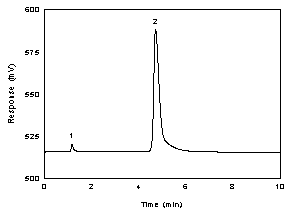
Figure
3.5.1 A chromatogram of 203 µg/mL acetic acid (200 µg/mL acetate
ion) in 0.01 N NaOH. (Key: (1) water; (2) acetate ion.) |
| flow rate: |
1.4 mL/min |
| eluent: |
1.5 mM
Na2B4O7 |
| pump pressure: |
1200psi |
| injection size: |
50 µL
|
| retention time: |
4.8 min acetate ion
|
3.5.2 Peak areas are
measured by an integrator or other suitable means.
3.5.3 An
external standard (ESTD) calibration method is used. A calibration
curve can be constructed by plotting response of standard injections
versus milligrams of analyte per sample. Bracket the samples with
freshly prepared analytical standards over a range of
concentrations.
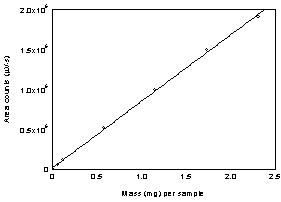
Figure
3.5.3. Calibration cruve of acetic
acid.
(Y=8.32x105 x+
2.20x104). | 3.6 Interferences (analytical)
3.6.1 Any compound that produces a IC
response and has a similar retention time as the analyte is a
potential interference. If any potential interferences were reported,
they should be considered before samples are extracted. Generally,
chromatographic conditions can be altered to separate an interference
from the analyte. Butyric acid, as the butyrate ion, is an
interference on the AS4A analytical column, therefore an AS14A
analytical column should be used to analyze samples from workplaces
where butyric acid is present.
3.6.2 When necessary, the
identity or purity of an analyte peak may be confirmed by mass
spectrometry or by another analytical procedure. The sample must be
acidified with sulfuric acid or phosphoric acid to a pH of 3 or less,
to reform the acetic acid from the acetate ion, before it can be
confirmed by GC mass spec. The mass spectrum in Figure 3.6.2.
Confirmation of the acetate ion is also possible by analysis by
capillary electrophoresis or by a second column on IC.
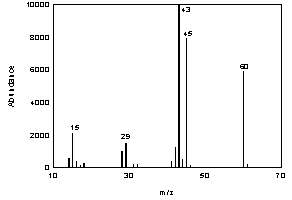
Figure
3.6.2. The mass spectrum of acetic
acid. | 3.7
Calculations
The amount of analyte per sampler is obtained from
the appropriate calibration curve in terms of micrograms per sample,
uncorrected for extraction efficiency. If the instrument was calibrated
on the concentration of the acetate ion, the results need to be
converted to acetic acid concentration by multiplying the acetate ion
concentration by a ratio of their molecular weights (60.05/59.04). This
total amount is then corrected by subtracting the total amount (if any)
found on the blank. The air concentration is calculated using the
following formulas.
 |
where: |
CM is concentration by
weight (mg/m³) |
|
M is
micrograms per sample |
|
EE is extraction efficiency, in
decimal form |
|
V is liters
of air sampled |
|
|
|
 |
where: |
where CV is concentration by volume (ppm)
|
|
VM is molar volume at 25º C
and 1 atm = 24.46 |
|
CM is concentration by weight
|
|
Mr is molecular weight = 60.05
| 4.
Recommendations for Further Study
Collection, reproducibility, and
other detection limit studies need to be performed to make this a
validated method.
1 OSHA Sampling and
Analytical Methods. http://www.osha-slc.gov/ (accessed
6/21/02).
2 Lewis, R., Sax’s Dangerous Properties of Industrial Materials,
Tenth Ed., Vol. 2, Van Nostrand Reinhold: New York, 2000,
p15.
3 O’Neil, M.J., Ed, The Merck index, Merck & Co. Inc. Whitehouse
Station, NJ, 2001, p 56.
4 ChemExpo
Chemical Profiles. http: www.englib.cornell.edu (accessed
6/21/02).
5 O’Neil, M.J., Ed, The Merck index, Merck & Co. Inc. Whitehouse
Station, NJ, 2001, p 56.
6 Lewis, R.,
Sax’s Dangerous Properties of Industrial Materials,
Tenth Ed., Vol. 2, Van Nostrand Reinhold: New York, 2000,
p15.
7 OSHA Chemical Sampling Information.
http://www.osha-slc.gov/ (accessed
6/21/02).
8 Burright, D.; Chan, Y.; Eide,
M.; Elskamp, C.; Hendricks, W.; Rose, M. C. Evaluation
Guidelines for Air Sampling Methods Utilizing Chromatographic
Analysis; OSHA Salt Lake Technical Center, U.S. Department of
Labor: Salt Lake City, UT, 1999.
|

